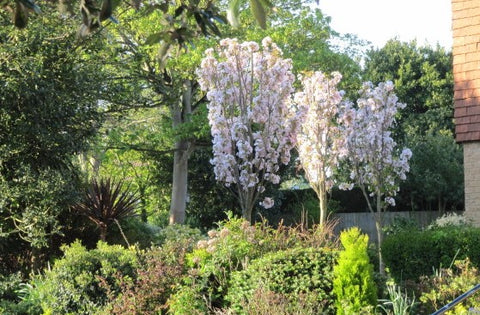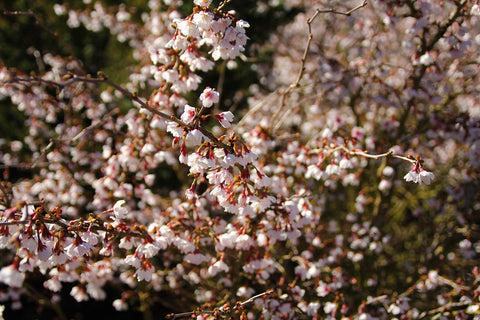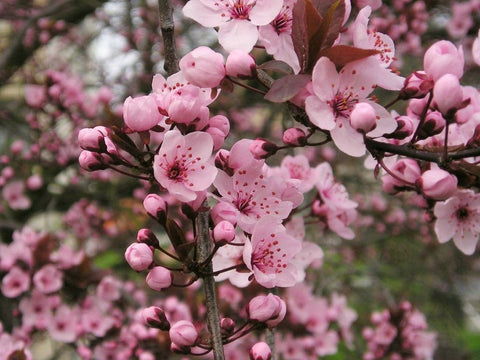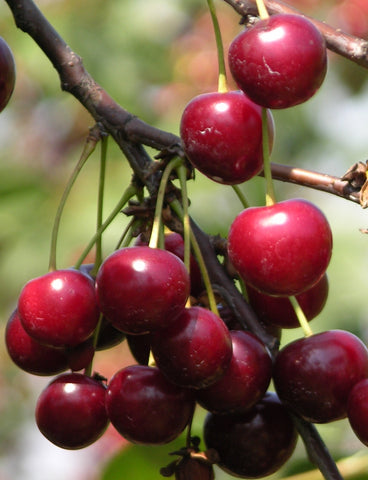Hanami: Say goodbye to winter with flowering cherry trees.

By Veronica
Let's delve into the beautiful tradition of Hanami, the Japanese custom of enjoying the transient beauty of cherry blossoms as a way to welcome spring. No need to travel thousands of miles for that as the Japanese cherry trees grow well in Ireland and will reward you with a spectacular show of a myriad of small flowers, spreading in the wind like confetti. Most cherry trees are small, perfectly suited for city gardens, with flowers in shades of white or pink.
Not only are they pretty, they provide a valuable food source for pollinators in Spring with their nectar rich blooms.
Here are some beautiful varieties to grow that will leave you in awe.
Kiku-Shidare-Zakura, ‘The Weeping Chrysanthemum Cherry’

You have guessed it, ‘Kiku-Shidare-Zakura’ bears arching branches. In late April, it produces masses of fully double, pink flowers before the bronze leaves appear. The foliage matures to green before turning bronze-orange in Autumn.
This is one of the best weeping cherry tree, best when planted as a standalone.
Height and Spread: 3.5 x 3.5 m typically.
Tai-Haku, ‘The Great White Cherry’

On the larger side, ‘Tai-Haku’ is a showstopper. Its pure white, single flowers are bigger than most varieties, reaching 6 cm across. Foliage is borne bronze before turning green in Summer adding interest to the garden. A great choice for bigger gardens, it also holds the prestigious RHS Award of Garden Merit.
Height and Spread: 8 x 8 m.
Shirotae, ‘The White Cloth’

The name is pretty self-explanatory, ‘Shirotae’, also called ‘Mount Fuji’, is a stunning white flowering cherry tree producing semi-double white flowers. The large (5cm across) and fragrant flowers adorn this spreading tree in Spring, followed by green, young leaves. These turn orange and red in autumn for another colourful display in the back season.
RHS Award of Garden Merit.
Height and Spread: 8 x 8 m.
Kanzan, ‘Bordering Mountain’

‘Kanzan’ is an old Japanese word evoking the picturesque village of one’s birth. It takes you back to memories of childhood. The tree itself is certainly one of the most sought-after variety and for good reasons. The rich pink, double flowers appear in Spring, opening from crimson buds. They are followed by leaves, borne bronze-green before turning green in Summer.
RHS Award of Garden Merit
Height and Spread: 8 x 6 m.
Amanogawa, ‘Milky Way’

Also called the Flagpole Cherry tree, ‘Amanogawa’ is an erect, narrow variety that will suit any garden. Ideal to bring some height at the back of your borders, it turns into a column of lightly fragrant, semi-double, light pink flowers in late Spring. The leaves emerge bronze after flowering, turn green in Summer and finally, red and orange in Autumn.
RHS Award of Garden Merit.
Height and Spread: 8 x 2.5 m.
Autumnalis Rosea, The winter flowering cherry tree

Flowering on and off during mild spells throughout the winter and until March, Autumnalis Rosea has the longest flowering season of them all. The pale pink flowers are fairly small and semi-double. The foliage turns orange and yellow in Autumn.
Height and Spread: 8 x 4 m.
‘Brilliant’, a dwarf and resilient variety
As for the small specimens, ‘Brilliant’ is a great addition to the city garden as it is tolerant of most conditions , including pollution. The Japanese alpine cherry tree bears white flowers with a pink flush, contrasting beautifully with the chestnut-brown bark. The leaves emerge rusty-bronze, turn green in summer and finally orange and red in autumn.
Height and Spread: 3 x 2 m.
Kojo-No-Mai, ‘Flight of the butterflies’.

The smallest flowering cherry tree is also one of the most attractive all year-round. In spring, the abundant, single, white/light pink flowers are a delight. In Autumn, the foliage takes fiery tones, before falling off and revealing the zig-zag branches. It can be grown in a large container where it will show off its features.
RHS Award of Garden Merit
Height and Spread: 2 x 2 m.
‘Nigra’, The Black Cherry Plum

If you are looking for rich colours, then ‘Nigra’ is a wonderful choice. The single pink flowers, open from deep pink buds in Spring and look amazing against the purple branches and twigs. The blackish-purple foliage will also add interest to your garden during the summer months.
It is a large variety, preferred in medium to large sized gardens.
RHS Award of Garden Merit.
Height and Spread: 12 x 8 m.
‘Morello’, The edible one

‘Morello’ is not a Japanese cherry blossom but it is pretty none-the-less. Just like the other Prunus Cerasus, the flowering is remarkable and this tree produces abundant, small, white, single flowers very attractive to pollinators. These make space for the fruit, in summer, one of the best sour cherry variety. The small, dark red cherries are perfect for preserves and tarts. It is a reliable good cropper too that can be grown in a large pot or trained against a wall, adapting very well to small gardens.
RHS Award of Garden Merit
Height and Spread: 4 x 4 m.
Caring for your cherry blossom
Planting: Plants in pots can be planted all year-round, however, Spring and Autumn are the best times as the soil is moist enough without being too cold.
Dig a hole at least twice the size of the pot, break up the soil.
Loosen gently the roots of the tree and rub with RootGrow (optional but highly recommended for specimen trees as it will considerably help the establishment of the plant).
Place the tree in the hole and backfill with the remaining soil, mixed with compost. Make sure that the soil is at the same level as it was in the pot.
Larger trees may need staking for the first few years.
Where: Some varieties can be grown in pots. In general, for cherry blossoms, choose a site in full sun and relatively sheltered so you can enjoy the flowering season for longer. The sour cherry can be grown in partial shade.
They are tolerant of a very large variety of soils, avoid, however, very heavy ones or amend the soil adequately to improved drainage by adding sand/grit and soil improver.
Pruning: Cherry blossoms only need a light pruning to remove damage or diseased branches. Do so in late winter or early spring. Mulch and feed then.




Leave a comment